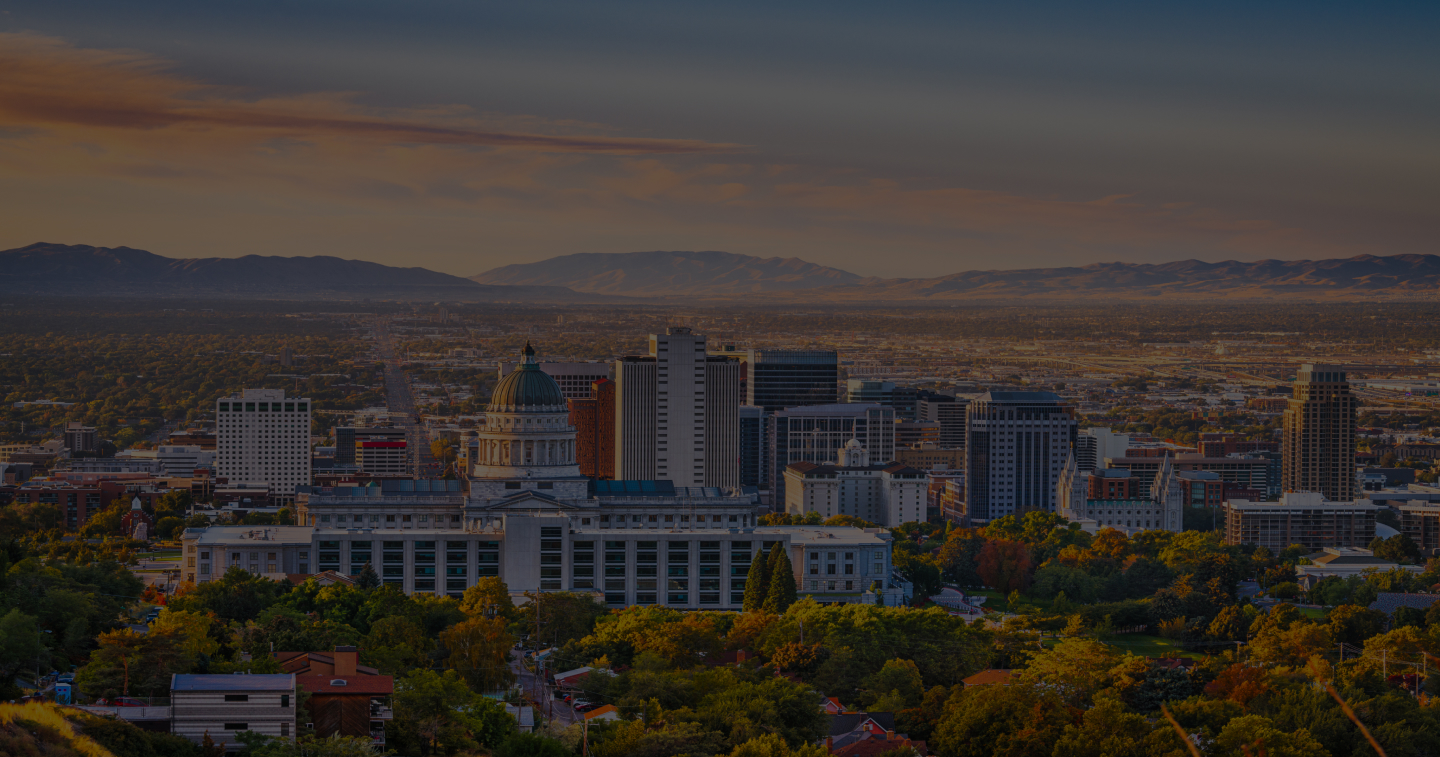
Navigating through Utah’s diverse landscapes, drivers encounter roads that range from serene country paths to bustling city thoroughfares. However, a few particular roads stand out for their notorious reputation. The identification of these hazardous roads are not based on hearsay but on a thorough analysis of traffic data, including accident rates, fatality statistics, and overall road conditions. These roads, winding through Utah’s varied terrain, present a unique set of challenges to even the most experienced drivers, making them the most dangerous roads in the state.
Interstate 15
Spanning from the Arizona border through major cities like St. George and Salt Lake City, I-15 is notorious for high speeds and heavy traffic congestion, particularly near the “Spaghetti Bowl” interchange. It’s infamous for its high-speed traffic, leading to frequent and often severe collisions. The areas surrounding major cities like Salt Lake City are especially dangerous due to the combination of heavy traffic, high speeds, and frequent lane changes. Drivers need to be particularly vigilant during peak hours when the risk of multi-vehicle accidents increases.
Parley’s Canyon
This route is as beautiful as it is dangerous. Connecting Salt Lake City to Summit County, Parley’s Canyon is often congested, especially during ski season, posing risks with its steep inclines and sharp turns. It requires drivers’ utmost attention, particularly in winter months. Snow and ice can transform this canyon road into a slippery trap, significantly increasing the risk of accidents. Drivers should be prepared for sudden weather changes and ensure their vehicles are equipped for harsh conditions.
Moki Dugway Scenic Backway
This unpaved, gravel road near Valley of the Gods is a challenge even for experienced drivers. With its steep grades, tight switchbacks, and lack of guardrails, Moki Dugway Scenic Backway offers breathtaking views alongside vertiginous drops. The road’s condition can deteriorate quickly with weather, making it particularly hazardous after rain or snow. It’s advised to avoid this road during inclement weather and always to drive with caution.
Interstate 80
Stretching from California to Denver, interstate 80 sees heavy traffic flow, including large trucks. This interstate spans the Salt Lake Valley and is a hub for both local and long-distance traffic. Its risks are compounded by high-speed travel and frequent lane shifts, especially near construction zones. Drivers should be mindful of changing traffic patterns and maintain safe following distances to react to sudden stops or lane changes.
Washington Boulevard (Ogden)
This urban thoroughfare experiences a diverse mix of traffic, including heavy trucks and pedestrian crossings. The high traffic volume increases the likelihood of rear-end collisions and accidents involving pedestrians. Drivers are advised to be particularly cautious during rush hours and in areas with high pedestrian activity.
Interstate 70
This route, offering access to various national parks, including Zion, is known for its scenic beauty but also for its high speeds and long stretches without services, contributing to fatigue-related incidents. Interstate 70 is known for its remote stretches, where services like gas stations and rest stops are sparse. The road’s isolation, combined with sudden elevation changes and unpredictable weather, can catch unprepared drivers off guard. It’s crucial to plan your journey on this route, ensuring your vehicle is well-maintained and equipped for emergencies.
Highway 6
Connecting Spanish Fork and Green River, Highway 6 is notorious for its dangerous curves and high fatality rates, making it one of Utah’s deadliest roads. Traversing central Utah, this Utah highway is a challenging drive due to its combination of heavy truck traffic, sharp curves, and frequent elevation changes. It requires constant vigilance from drivers, as the combination of factors can lead to fatigue and reduced reaction times. Drivers should be particularly cautious around blind curves and when navigating the road’s steeper sections.
Safe Driving Tips for Navigating Dangerous Utah Roads
Navigating Utah’s most dangerous roads requires more than just driving skills. It demands awareness and preparation. Here are some essential safety tips for drivers:
Stay Alert on Interstate 15: Given its high traffic and speed, staying alert and avoiding distractions is crucial on this road.
Drive Cautiously in Parley’s Canyon: During winter, reduce your speed and maintain a safe distance from other vehicles to navigate its turns safely.
Prepare for Moki Dugway Scenic Backway: Check your vehicle’s brakes and tires before tackling this steep and rugged terrain. Drive slowly and watch for oncoming traffic on narrow sections.
Be Vigilant on Interstate 80: Watch for sudden stops and be particularly cautious in construction zones.
Urban Awareness on Washington Boulevard: High traffic volumes require increased vigilance. Watch for pedestrians and cyclists, especially at intersections.
Plan Ahead for Interstate 70: Ensure you have enough fuel, water, and supplies, as services are sparse along this route.
Navigate Highway 6 with Care: Pay attention to the road’s curves and elevation changes, and be mindful of truck traffic.
By following these tips, you can significantly reduce the risk of accidents and ensure a safer journey on Utah’s roads.
Legal Perspective: What to Do After a Car Accident in Utah
Being involved in a road accident on Utah’s dangerous roads can be a traumatic and confusing experience. Knowing the legal steps to take after a car accident is crucial for protecting your rights and interests. Here’s what you should do:
Ensure Safety and Seek Medical Attention: Your first priority should be your safety and the safety of others. Move to a safe location if possible and call emergency services for anyone injured.
Report the Accident: It’s important to report the accident to the police, especially if there are injuries or significant property damage. A police report can be vital in legal proceedings.
Document the Scene and Gather Information: If you’re able, take photos of the accident scene, including vehicle positions, road conditions, and any relevant road signs. Collect contact and insurance information from all parties involved.
Notify Your Insurance Company: Inform your insurance company about the accident as soon as possible. Be honest about the details, but avoid admitting fault or making statements that could be used against you.
Seek Legal Advice: Before accepting any settlements or signing documents from insurance companies, it’s wise to consult with a personal injury attorney. Law firms like Parker & McConkie specialize in road accident cases and can guide you through the process to ensure fair compensation.
Keep Records of Everything: Keep a detailed record of all medical treatments, communications with insurance companies, and any expenses related to the accident. These records can be crucial in legal proceedings.
Understand Your Rights and Options: Every accident case is unique, and understanding your rights is crucial. A skilled attorney can help you navigate the complexities of liability, insurance claims, and potential compensation.
The aftermath of a road accident can be overwhelming, but taking these steps can help protect your legal rights and provide a clearer path to recovery and compensation.
Understanding Liability and Insurance in Car Accidents
Navigating the legal nuances of liability and insurance after a road accident in Utah can be complex. Understanding these aspects is crucial for anyone involved in an accident, especially on Utah’s most dangerous roads. Here’s an in-depth look at what you need to know:
Understanding Liability: In Utah, determining who is at fault in a road accident is essential since it impacts how damages are awarded. Utah follows a “modified comparative negligence” rule, meaning that if you are less than 50% at fault, you may still recover damages, but your compensation is reduced by your percentage of fault.
Insurance Claims Process: After an accident, you’ll likely deal with insurance claims. Utah requires drivers to have personal injury protection (PIP) as part of their insurance. This coverage can help pay for medical expenses, regardless of who is at fault.
Dealing with Insurance Companies: It’s important to handle communications with insurance companies carefully. They often try to minimize payouts. Avoid admitting fault or agreeing to a settlement without consulting a lawyer, as this can affect your compensation rights.
Role of Personal Injury Lawyers: An experienced personal injury lawyer can guide you through the claims process, negotiate with insurance companies, and if necessary, represent you in court to ensure you receive fair compensation.
Collecting Evidence for Your Claim: Strong evidence is key to supporting your claim. This includes police reports, witness statements, medical records, and any other documentation that proves the extent of your injuries and the other party’s liability.
Understanding Policy Limits: Be aware of the policy limits of the involved insurance policies. These limits can affect the amount of compensation you can receive. In cases where damages exceed these limits, pursuing a lawsuit might be necessary.
Statute of Limitations: In Utah, there is a four-year statute of limitations for filing a personal injury lawsuit. It’s important to start the legal process promptly to avoid being barred from seeking compensation.
Understanding these aspects can make a significant difference in the outcome of your insurance claim or lawsuit. With the right legal guidance, navigating the aftermath of a road accident becomes more manageable, ensuring your rights are protected every step of the way.
If you ever find yourself involved in an accident on these roads, it’s crucial to know the right steps to take. For experienced guidance and support in such situations, consider reaching out to a Utah law firm like Parker & McConkie. Our experience in road accident cases can be invaluable in navigating the legal process, ensuring your rights are protected, and helping you secure fair compensation. Remember, you don’t have to face this journey alone. Professional legal support from car accident lawyers can make a significant difference in your road to recovery and justice. Schedule a free consultation today!
Contact the Utah Car Accident Lawyers at Parker & McConkie Today
For more information, please contact an experienced car accident lawyer at Parker & McConkie to schedule a free initial consultation today. We have 5 convenient locations in Utah, including Midvale, Salt Lake City, Ogden & Provo, UT. Clients can also visit our offices in Idaho Falls, ID & Rock Springs, WY.
We proudly serve Weber County, Utah County, Salt Lake County in Utah, Bonneville County in Idaho, Sweetwater County in Wyoming , and its surrounding areas:
Parker & McConkie Personal Injury Lawyers – Salt Lake City Office
466 S. 500 E., Suite 100,
Salt Lake City, UT 84102
(801) 851-1202
Hours: 24/7
Parker & McConkie Personal Injury Lawyers – Midvale Office
7090 Union Park Ave, #160,
Midvale, UT 84047
(801) 845-0440
Hours: 24/7
Parker & McConkie Personal Injury Lawyers – Ogden Office
2510 S Washington Blvd, Suite 160,
Ogden, UT 84401
(385) 402-8187
Hours: 24/7
Parker & McConkie Personal Injury Lawyers – Provo Office
37 E Center St, Suite 300,
Provo, UT 84606
(801) 876-4107
Hours: 24/7
Parker & McConkie Personal Injury Lawyers – Rock Springs Office
531 N Front St,
Rock Springs, WY 82901
(307) 205-7400
Hours: 24/7
Parker & McConkie Personal Injury Lawyers – Idaho Falls Office
2235 East 25th St. Suite #280,
Idaho Falls, ID 83404
(208) 418-0633
Hours: 24/7



